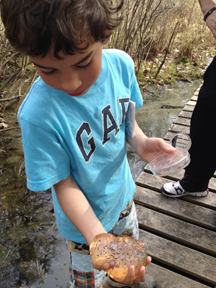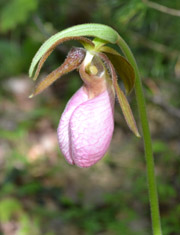Sebago Lake Land Reserve: Unique Ecological Features


The 1700-acre Sebago Lake Land Reserve was opened to the public in 2005. Recent trail improvements, signs, and an accompanying map have made the trail network of the Land Reserve more user-friendly and accessible. The Land Reserve is home to a bounty of unique ecological features and recreational opportunities.
Many features of the Land Reserve, sharp elevation changes in particular, were shaped by glacial movement 13,000 years ago. The steep slope that runs between Bobcat Trail and Horsetail Trail is called a kame slope and was formed by glacial deposits. This stark contrast in elevation results in markedly different plant communities. A maze of springs, streams, and wetlands borders the Horsetail Trail, which can be found at the bottom of the kame slope. A comparison of plant communities between the bottom and the top of the kame slope may reveal the hidden story of soil and hydrology underfoot.
The Otter Ponds are a testament to previous glacial activity and are a type of kettlehole depression. Kettlehole depressions were formed from glacial ice that became trapped in layers of sand and gravel that, once melted, left rounded, steep-sided depressions. The Otter Ponds (the collection of Half Moon Pond, Otter Ponds, and Snake Pond) are spring-fed ponds known as kettlehole lakes. These ponds are a popular destination for brook trout, largemouth bass, pickerel, and hornpout anglers and are accessible along Mallard Trail. The Otter Ponds are bordered by a set of trails that provide contrasting settings of a predominantly dense White Pine tree community along the Acadia Loop and the sun flecked Oak-dominated tree community along the Snake View and Pond View Trails. Sightings of cicadas, Great Blue Herons, Belted Kingfishers, Cedar Waxwings, snakes, several butterfly and moth species, and frogs near the Otter Ponds add to the appeal of these trails.
The Otter Ponds are not the only place to spot wildlife. Vernal pools and their amphibian inhabitants are scattered throughout the land reserve. These seasonally filled pools assist in reducing erosion and polluted runoff by holding water from spring rains and slowly releasing it back into the ground. Additionally, vernal pools provide a safe habitat for breeding amphibians that rely on fishless waterbodies to lay their eggs. Several species, including the spotted salamander, blue spotted salamander, wood frog, and fairy shrimp, all rely on vernal pools exclusively to raise their broods. The animals that call these unique habitats home are food for many other animals like the Barred Owl, raccoons, foxes, and hawks. The Wetland Loop offers excellent views of such a habitat and is the perfect length for children.